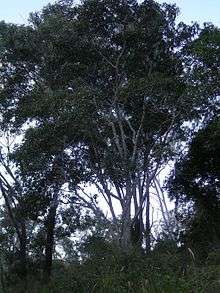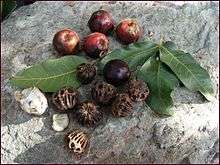Pleiogynium timoriense
| Pleiogynium timoriense | |
|---|---|
 | |
| Scientific classification | |
| Kingdom: | Plantae |
| Clade: | Angiosperms |
| Clade: | Eudicots |
| Clade: | Rosids |
| Order: | Sapindales |
| Family: | Anacardiaceae |
| Genus: | Pleiogynium |
| Species: | P. timoriense |
| Binomial name | |
| Pleiogynium timoriense (DC.) Leenh. | |
Pleiogynium timoriense, commonly known as the Burdekin plum, is a medium-sized fruit-bearing tree native to Malesia, Australia and the Pacific Islands.[1]

This semi-deciduous tree can naturally reach up to 20 m high but in cultivation generally grows to approximately 12 m. It has a dense canopy with glossy dark green leaves and rough dark bark. The tree has yellowish-green flowers which flower between January and March and later grow into a fruit. The fruit's flesh is generally plum coloured however, white varieties have been reported. The fruit is edible when ripe. Fruit must be removed from tree to ripen for several days in a dark, damp place. Native aboriginals are known to have buried the fruit underground to ripen. Fruit can be cooked, eaten raw or used in jellies, jams and preserves.[2][3][4]
The species occurs in Indonesia, Malaysia, Papua New Guinea, the Philippines, Australia (Queensland), the Cook Islands, Fiji, the Solomon Islands and Tonga.[1]
References
- 1 2 "Pleiogynium timoriense". Germplasm Resources Information Network (GRIN). Agricultural Research Service (ARS), United States Department of Agriculture (USDA). Retrieved 24 July 2013.
- ↑ Pleiogynium timorense
- ↑ "Burdekin Plum". Bush Tucker. SGAP(Qld).
- ↑ Pleiogynium timorense
Further reading
- Netzel, Michael; Netzel, Gabriele; Tian, Qingguo; Schwartz, Steven; Konczak, Izabela (22 November 2006). "Sources of Antioxidant Activity in Australian Native Fruits. Identification and Quantification of Anthocyanins". Journal of Agricultural and Food Chemistry. 56 (26): 9820–6. doi:10.1021/jf0622735. PMID 17177507.
External links
- "Pleiogynium timoriense (DC.) Leenh". Atlas of Living Australia.
![]()